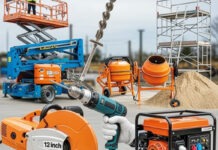Project for the new SB 300 Fixed-Width Screed from VÖGELE: the fixed-width screed demonstrated its benefits right from the start during a project to lay a major road. It processed complex materials such as porous asphalt and stone mastic asphalt in large widths. The result was a convincing one.
Fixed-width screeds are frequently used when large widths need paving without joints. This was the case for a new section of the B75 in Hamburg, called the “Wilhelmsburger Reichsstrasse”. This major road runs alongside the railway tracks for a distance of approximately 4.6 km. Bundling two large traffic routes in one place means that both the town and its inhabitants gain space and the noise pollution of the busy road is reduced for those living nearby. Paving was performed by a SUPER 2100-3i-type tracked paver. This Highway Class paver of the state-of-the-art “Dash 3” generation from VÖGELE is the machine of choice for a great many highway projects.
SB 300 Fixed-Width Screed: top-quality paving
For some time, both contractors and operators have had yet another reason to use the SUPER 2100-3i to work without joints in large widths: the SB 300 Fixed-Width Screed. In combination with the SUPER 2100-3i, it can pave a maximum width of 13 m. The asphalt paving work in Hamburg almost reached this limit: the binder and wearing courses were paved in a width varying between 10.5 and 12.5 m. To ensure that the carriageway resists deformation, one part was made of stone mastic asphalt, whilst a 2.2 km-long section was completed in porous asphalt to reduce noise.
When processing materials, compaction performance and the floating behaviour of the screed are of key importance. Both are highly dependent on the correct tamper setting. With hydraulic tamper stroke adjustment for the new fixed-width screeds, VÖGELE delivers an innovation which allows tamper stroke to be adjusted at the push of a button. It can be selected between 4 and 8 mm, the important point being that 4 mm are recommended for thin layers such as binder and wearing courses, whilst a stroke of 8 mm is recommended for thick base courses.
Hydraulic bolt-on extension increases variability to 2.5 m
Together with his paving team, construction manager Martin Iseke from contractors KEMNA BAU managed all the challenges faced on the B75 in style – due, among other things, to the latest screed technology from VÖGELE: “The new screed is very rigid; the immaculate evenness makes this clear. The new variability is another feature to highlight -paving without joints would have been impossible without it.”
Iseke is referring to a key new feature on the SB 300: the hydraulic bolt-on extension. This extension to the outside of the screed can be extended hydraulically – by 1.25 m on each side, so a total of 2.5 m. This enables VÖGELE to combine the advantages of its extending screeds with those of the fixed-width screeds: a high degree of flexibility plus maximum evenness. On this large-scale job site, the KEMNA BAU paving team pushed this advantage, too, almost to the maximum: pave width varied by around 2 m.
Other practical new features increase efficiency
The SB 300 can be combined with several VÖGELE pavers, from the SUPER 1800-3i to the SUPER 3000-3i. It has a basic width of 3 m and a variety of extensions can be used to increase it to a width of up to 16 m. The development team developed the SB 300 together with the SB 350. The latter delivers a pave width of 18 m which can be achieved in combination with VÖGELE’s flagship paver, the SUPER 3000-3i.
Two new/further developments on the SB 300 and SB 350 Fixed-Width Screeds ensure they are ready for action quickly: the guide and positioning system and the electric screed heating system. Whilst the guide and positioning system helps users fit the extensions correctly, the electric heating system brings the screed to operating temperature more quickly and more evenly than the preceding model.








